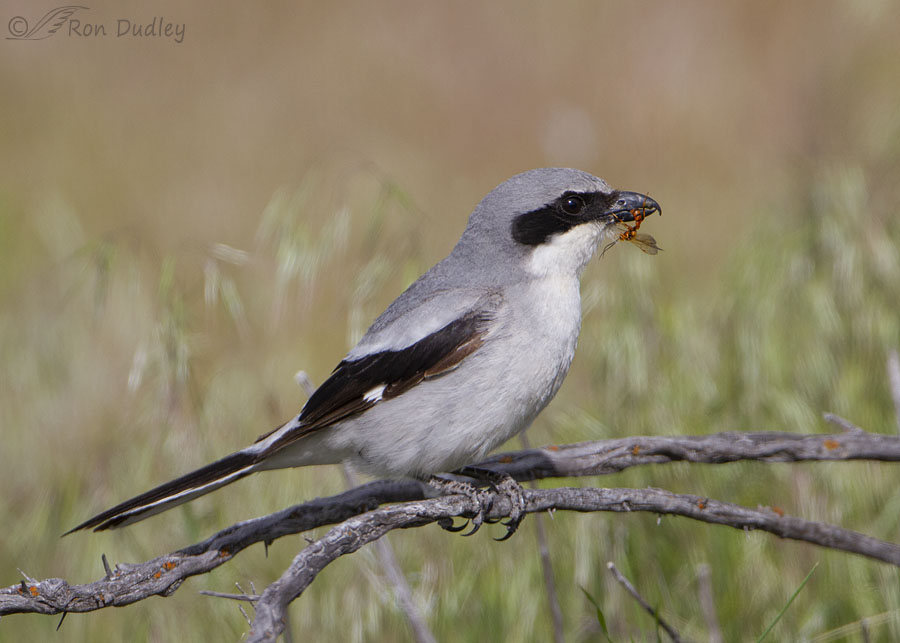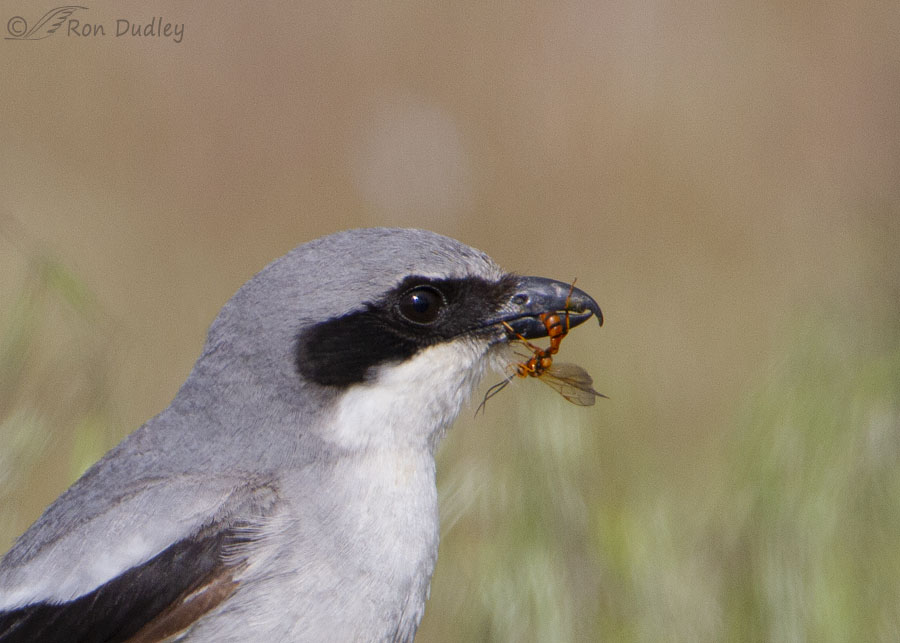It isn’t a yellowjacket, hornet or paper wasp but I still think it’s a wasp.

1/2000, f/6.3, ISO 500, Canon 7D, Canon EF 500mm f/4L IS II USM + EF 1.4 III Extender, not baited, set up or called in
I’m always interested in the prey items of the birds I photograph so when I found this Loggerhead Shrike on Antelope Island with an unusually-colored wasp in its bill it caught my attention.
Like many birds with stinging prey the shrike was careful to grasp the wasp by its abdomen so the stinger couldn’t do its dirty deed. At one point the shrike was in danger of being stung so ‘he’ deliberately dropped it, at least I think it was deliberate, but he was able to retrieve it.

The wasp was a pretty little thing but pretty or not I still don’t like’m.
I’ve had my share of very unpleasant encounters with wasps like hornets and yellowjackets and just two days ago I had to destroy eight paper wasp nests hiding beneath the top railing of my wooden deck. It was a delicate operation and I discovered that even this old man with a bad back can still run pretty damn fast when it’s absolutely necessary.
Yes I know, wasps are part of the natural scheme of things and they’re bird food but when I find them resident in my yard they’ve gotta go.
Ron
Note:
Notice the tomial tooth or “falcon tooth” on the upper bill of the shrike.
“Tomial Tooth: n. A protrusion on the upper bill of some birds—including falcons, kites, and shrikes—reminiscent of a tooth. The “tooth” and the corresponding divot in the lower mandible allow the bill to act like a pair of shears, which may make it easier for the predators to sever the spinal cords of their vertebrate prey.”


Excellent shots! Thanks for sharing!
Charlotte Norton
Thank you, Charlotte.
Loud applause for the Loggerhead Shrike from me. Years back I was stung in the underarm by a wasp while swimming. I am told that my gargled shriek and flailing were spectacular.
I hope your senior speed was successful in avoiding the peril.
And applause for the shot too.
“I am told that my gargled shriek and flailing were spectacular.”
Now that brought a smile, EC. A sympathetic one but still a smile.
I don’t think I wanna mess with Loggerhead Shrikes or wasps of any kind, happy to leave the latter to the former — glad you were able to make your getaway unscathed.
Thanks, Chris. They didn’t get me this time but they have in the recent past. I feel no guilt in wiping them out.
Remember Mad Magazine used to have Scenes We’d Like to See – that would be Ron Dudley running across his yard with a stream of wasps chasing him.
Me too! LOL!!
Everett, exactly that scene played out several times last year when I got too close to a very large nest of wasps with my lawnmower.
It IS a pretty wasp – as long as it’s where it is! Tomial Tooth is interesting and useful.
Tomial Tooth is interesting and useful.
Keeping my eye out for the nests in the usual places – yes, us “Sr.’s” CAN move fast when properly motivated! Caught a Bald Headed Hornet in one of my traps the other day – hoping it’s a queen after the devastation they caused to the honey bee hive in our old shack last year. Small honey bee swarm has moved in recently- always do sooner or later….. What we “allow” in the yard and out are 2 different things…..
Caught a Bald Headed Hornet in one of my traps the other day – hoping it’s a queen after the devastation they caused to the honey bee hive in our old shack last year. Small honey bee swarm has moved in recently- always do sooner or later….. What we “allow” in the yard and out are 2 different things…..
“Properly motivated” is key isn’t it Judy.
Your photo illustrates the tomial tooth better than I have seen before. Quite the prey item you caught him with. Makes one wonder what branch or thorn he’s going to impale it on to aid in dismembering.
Thanks, Lyle. It would have to be a pretty small thorn but shrikes are known to be resourceful.
Hi, Judy,
You might be aware of the competition honey bees pose to native bees – even in your yard? Honey bees (non-native) have large hives, while nearly all our 1,100 native bees in Utah are solitary (bumblebees form smaller colonies, starting from an individual queen bumblebee each year)– and native bees are in steep decline here and worldwide.
I have established a small organization (Project Eleven Hundred) focused on ending the permitting of honey bee hives (each with 10,000-60,000 honey bees, and permits existing for 10- 100 + hives) on BLM and Forest Service lands. And as you probably, know, honey bees from managed hives can then establish feral hives.
Interesting concept, Mary.
Loggerhead Shrikes, like Ron Dudleys, are pretty bad-ass when it comes to wasps! I’m always impressed by these wannabe raptors.
I’m always impressed by these wannabe raptors.
Ha, I sure as hell didn’t look very bad ass when I was running from those nasty devils.
What a lovely colour for a wasp. I would be the one though who couldn’t laugh at a real person or animal under attack by a swarm of them so am glad you got away safely. And, as a raptor fan I always love to see that tomial Bill shape so, on all 3 counts, Ron, job well done.
Much appreciated, Pat.